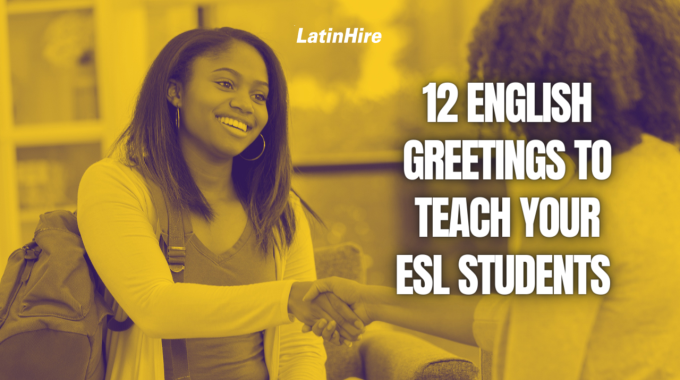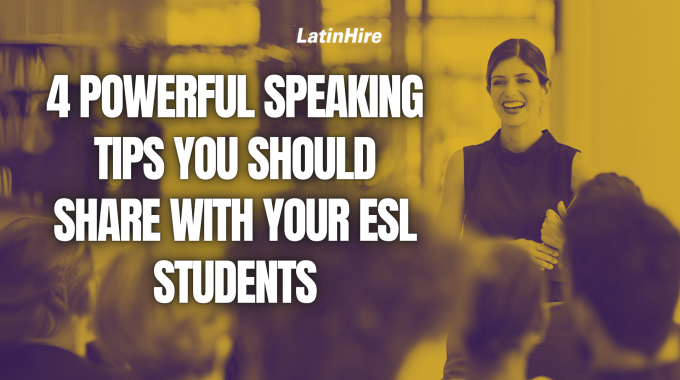As online ESL teachers, we all fall into the habit of starting our classes with…

12 English Greetings to Teach Your ESL Students
There are many ways to greet someone in English and depending on who you’re talking to, different types of greetings may be more appropriate. Greetings are usually the first things ESL students learn, but they’re often not taught all the variations of greetings.
It’s important to teach your students different greetings so they can make a good impression and be confident when meeting English native speakers, whether it’s new friends, colleagues or bosses.
Here are 12 English greetings to teach your ESL students:
Formal Greetings

1) Hello [name]
For a simple, yet polite greeting, a “hello” followed by their name will suffice. This shows that you know who you’re interacting with and kicks off the conversation to a good start. Depending on the relationship, you can either use their first name or their last name following Mr./Ms./Mrs.
2) Good morning/afternoon/evening
These greetings can be used with anyone and are great for greeting a group as well. “Good morning” is used before 12pm. “Good afternoon” is used between 12pm to 6pm and “Good evening” is usually used after 6pm. Note that in English, we do not use “Good night” as a greeting, rather it only works as a farewell.
3) How are you [doing]?
It’s a sign of politeness to ask how the other person is doing before getting into the main topics of the conversation. This question does not require a long, detailed response. Just a “I’m fine, and you?” is a perfectly appropriate way to respond. This question serves more as a greeting than a genuine question.
4) It’s a pleasure to meet you. / Pleased to meet you.
If you are meeting someone for the first time in a formal setting, it is important to say one of these phrases or a variation such as “It’s nice/great to meet you.” This shows that you are happy to meet the other person and starts off the interaction on a good foot. You may also want to follow up this greeting with a firm handshake.
5) How do you do?
This greeting is a bit old-fashioned, but is still used in business interactions or job interviews. Treat it like “How are you doing?” and respond with a simple “I’m fine/great, thank you.” (even if you’re having a bad day!) You may hear more of the older generations use this phrase.
6) How have you been?
If you have not seen someone for a long time, you can use this question to ask about how they’ve been since you last saw them. This may result in a longer response than “How are you?” because they may have something new to share about what’s been going on in their lives since you last met.
Informal Greetings

7) Hi/Hey/Hi there/Heya
These common variations of “hello” are used among friends and family or even strangers. They serve as a quick and polite way to acknowledge someone else’s presence. Be careful with your tone when using “Hey” with a stranger and not pronounce it too harshly because it may come off as rude or confrontational.
8) How’s it going?
This is the informal variation of “How are you doing?” and similarly only requires a short response like “Not too bad, and you?” Sometimes you could give a longer answer if it’s someone you’re very familiar with and you want to share more about your life. However, generally a brief, positive response is sufficient.
9) Morning/afternoon/evening!
These greetings can be used in place of “good morning”, “good afternoon” and “good evening”, but the timeframes remain the same. They’re often used more in informal settings and you can follow these up with a “How’s it going?”
10) What’s new? / What’s up? / How’s life?
With friends or people you have a very informal relationship with, you can use these questions usually following a “Hey”. It’s a relaxed way to ask how someone is doing and to see if there’s anything new going on in their lives. It can be considered rude to use these greetings with people older than you or in a professional setting.
11) Long time no see! / It’s been a while!
This is a great way to greet friends and family you haven’t seen in a long time. It shows that you’ve missed them and acknowledge their absence from your life. Many people choose to follow up these greetings with a warm embrace.
12) Yo, sup?
This is as informal as greetings can get. It is one level up from “Hey, what’s up?” and is used more among youngsters from the 2000s. This phrase was inspired by hip-hop culture and young people may find it cool to greet their friends this way.
We hope you enjoyed this article about English greetings! What other greetings do you use in different situations? Share them with us in the comments below!



